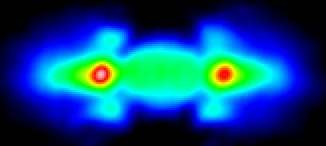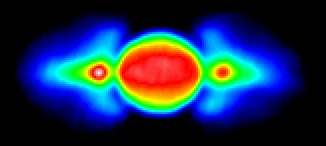Even though human ears can't hear the radio waves directly, they make an exciting listening experience when converted to audio signals by a receiver.
It's not E.T. phoning home. The shortwave radio signals from Jupiter aren't a sign of extraterrestrial intelligence. The emissions are generated naturally by plasma instabilities in Jupiter's magnetosphere.
Pulsing power beam. Most space physicists say that ionized gas in the upper atmosphere above Jupiter's magnetic poles sometimes behaves like a powerful radio laser or maser. The radiation can be so intense that Jupiter frequently outshines the Sun as a source of radio energy at ham radio wavelengths.
Where does the radio laser get so much power? It starts on Jupiter's volcanic moon Io.
 |
| RADIO IMAGE OF JUPITER |
Tidal forces from Jupiter and its other large satellites superheat the interior of the moon Io and make it the most volcanic body in the Solar System.
Volcanic materials are thrown far above Io's surface. Much of that enters orbit around Jupiter, forming a huge gaseous donut around the giant planet.
With a diameter the size of Io's orbit, the electrically conducting "Io torus," as it's known, spans 525,000 miles and has an important impact on Jupiter's magnetic environment.
Two trillion watts. As Io's orbital motion carries it through this magnetized ring of ionized gas, a huge electrical current flows between Io and Jupiter. Carrying about two trillion watts of power, it's the biggest DC electrical circuit in the Solar System.
Unlike the ordinary kind of DC circuit we know using batteries and wires, plasma physicists believe that current in the Io-Jupiter system is carried by a type of magnetic plasma wave called Alfven waves.
However it works, this awesome current is the power source for plasma waves that give rise to the laser radio signals that travel away from Jupiter's magnetic poles in cone-shaped beams.
The beams rotate with the giant planet every 9 hours and 55 minutes making Jupiter something like a slow-turning pulsar. When the beams sweep past our planet Earth, listeners here can pick up the Jovian radio bursts in the shortwave bands between 15 and 40 MHz.
 |
| RADIO IMAGE OF JUPITER |
| The radio images of Jupiter on this page were recorded by the Australia Telescope National Facility (ATNF) of the Commonwealth Scientific and Industrial Research Organisation (CISRO). The Australia Telescope is a set of eight radio-receiving dish antennas at three sites in New South Wales. It is the largest single astronomical institution in Australia. The image at the top of this page was received by ATNF at a wavelength of 22cm. The image immediately above was received by ATNF at a wavelength of 13cm. By comparison, the amateur Radio JOVE telescopes observe Jupiter at wavelengths near 1500 cm. |
Amateur astronomers, ham radio enthusiasts, shortwave listeners and students in middle schools, high schools and colleges can tune in, too.
NASA scientists at the Goddard Space Flight Center in Maryland, along with others at the University of Florida, are helping the public tune in and inspiring thousands to look up and listen to the biggest planet in the Solar System.
NASA has come up with a $115 radiotelescope kit that a school science class or other interested observers can put together. The kit includes all of the parts required to construct a 20 MHz radio receiver.
It comes with the necessary transmission cables and wire for the dual antennas, which are of a common type that ham radio operators call half-wave dipoles. Each antenna is about 20 feet long. They should be mounted 20 feet apart.
The kit doesn't include the PVC pipe recommended for mounting the wires. However, PVC is inexpensive at local hardware stores. Alternatively, wood could be used for mounting the antennas.
How sensitive is it? The kit makes a radiotelescope capable of detecting the giant planet hundreds of millions of miles away from Earth.
Bill Pine is a California high school teacher who is distributing the NASA Radio JOVE kits through The INSPIRE Project, Inc., a non-profit educational corporation, to schools, amateur radio operators and other interested individuals.
Once they build their own radiotelescopes, the new amateur astronomers make observations, which help scientists monitor activity in Jupiter's enormous magnetosphere.
What does it sound like? When it comes to sound effects, NASA says woodpeckers and ocean waves can't hold a candle to Jupiter.
There are two varieties of Jovian radio bursts:
- Through the loudspeaker of a shortwave receiver, the so-called "L-burst" sounds like ocean waves crashing on a distant beach. The "L" stands for long. If a recording is slowed down dramatically, the S-burst sound like eerie drifting whistlers.
- Through the loudspeaker of a shortwave receiver, the so-called "S-burst" produces a staccato of rapid popping sound with a beat that reminds some of woodpeckers. The "S" stands for short.

S-BURSTS |

L-BURSTS |
Student Observing Party. One of the first Radio JOVE student teams was at the Lexington Traditional Magnet School in Lexington, Kentucky. Students, teachers and parents set up an observing station on a teacher's farm at Mt. Sterling, Kentucky, on Oct. 22, 1999. Signals from Jupiter came through loud and clear.
What if you can't build one? For those who can't build their own radiotelescope, there is an online observatory where anyone can monitor Jupiter and receive live data on the World Wide Web.
The University of Florida Radio Observatory (UFRO), in a central Florida pine forest near the mouth of the Suwannee River, has an array antennas capturing shortwave radio signals from Jupiter and the Sun.
UFRO has been collecting Jupiter radio data there since the mid-1950's. Today, it is known as North America's best facility for low-frequency planetary radio astronomy.
The Sun also shines. Like Jupiter, the Sun is a powerful source of shortwave radio bursts. Solar radio activity is especially high around the so-called solar maximum, which began in the year 2000.
Recording solar bursts is another way to test the completed Radio JOVE Project radiotelescope kits and learn about the powerful processes that produce solar storms and flares.
Bonus Audio. In addition to receiving natural radio signals from Jupiter, you now can listen to ten seconds of very low frequency audio sounds of Jupiter captured by the Cassini spacecraft as it passed by in 2000 on its way to Saturn. The low radio frequencies received by Cassini were converted by NASA to sound wave frequencies for this RealAudio file.
Learn more about Jupiter and radioastronomy
- Exploring Jupiter main page
- Planet Jupiter NASA JPL Galileo
- Radio JOVE Project NASA Goddard Space Flight Center
- The Sounds of Jupiter NASA
- University of Florida Radio Astronomy Observatory online
- Jupiter Radio Japan
- The Discovery of Jupiter's Radio Emissions
- Exploring Jupiter's Magnetosphere American Geophysical Union
| Read more about the Solar System . . . | |||||
|---|---|---|---|---|---|
| Star: | The Sun | ||||
| Inner Planets: | Mercury | Venus | Earth | Mars | |
| Outer Planets: | Jupiter | Saturn | Uranus | Neptune | Pluto |
| Other Bodies: | Moons | Asteroids | Comets | ||
| Beyond: | Pioneers | Voyagers | |||